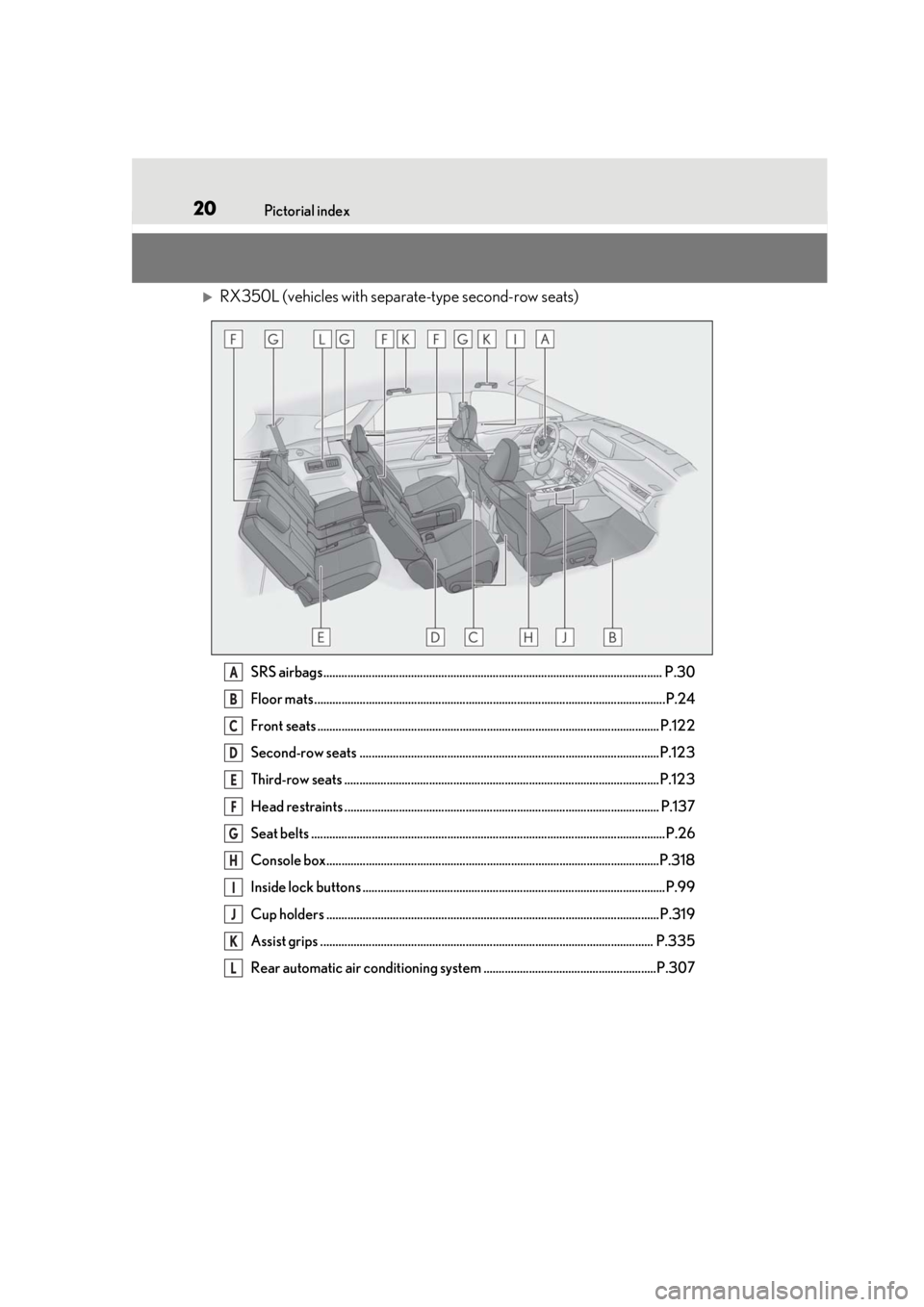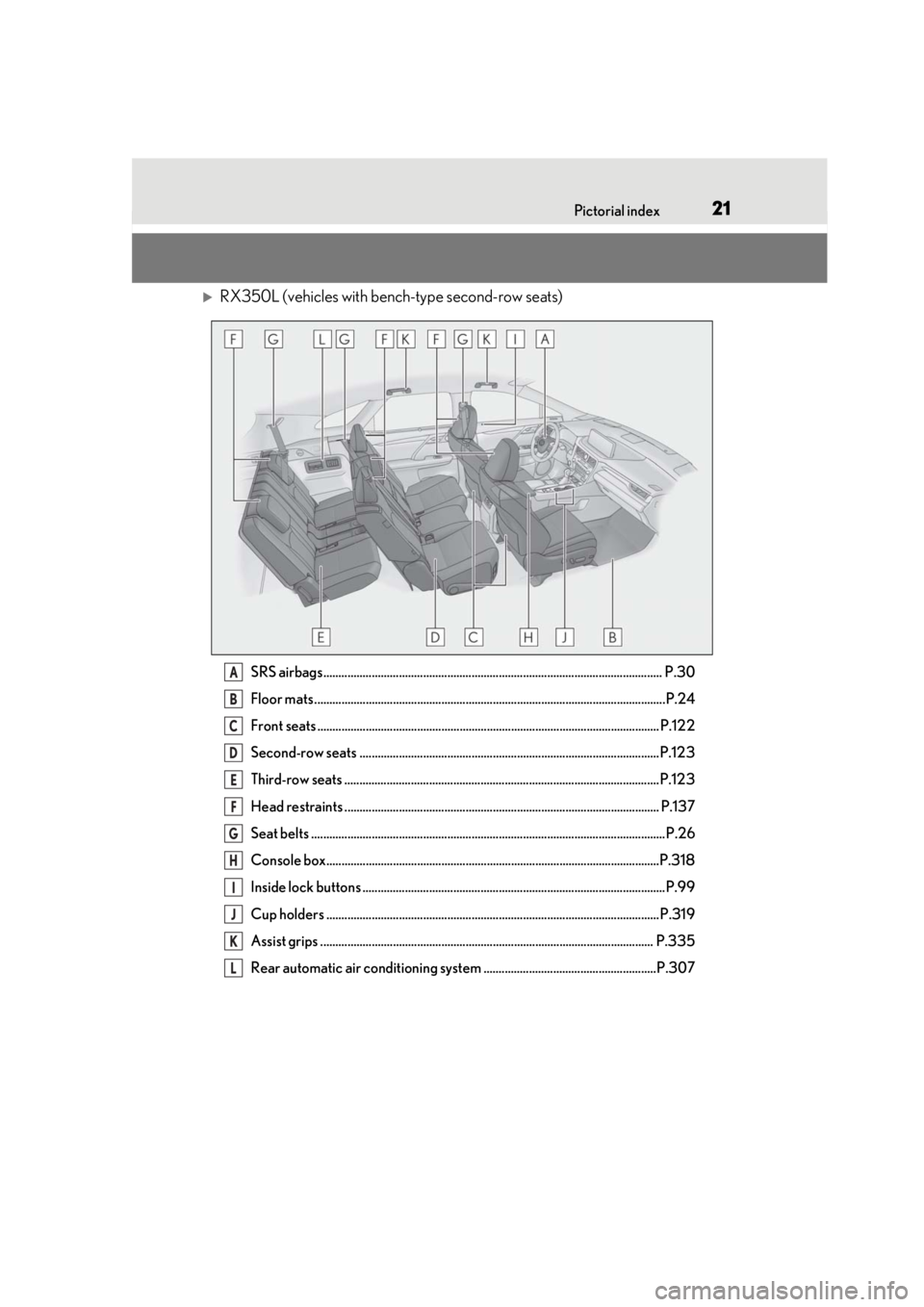2020 LEXUS RX350 air conditioning
[x] Cancel search: air conditioningPage 3 of 516

3TABLE OF CONTENTS
1
2
3
4
5
6
7
8
9
Trailer towing (vehicles with towing package) ........................................ 165
Dinghy towing ................................ 175
4-2. Driving procedures Engine (ignition) switch .............. 176
Automatic transmission.............. 180
Turn signal lever............................. 184
Parking brake ................................. 185
Brake Hold....................................... 188
4-3. Operating the lights and wipers Headlight switch ............................ 190
Automatic High Beam ................ 193
Fog light switch .............................. 195
Windshield wipers and washer ............................................................ 196
Rear window wiper and washer ........................................................... 200
4-4. Refueling Opening the fuel tank cap........ 202
4-5. Using the driving support systems Lexus Safety System + 2.0 ....... 205
PCS (Pre-Collision System)...... 211
LTA (Lane Tracing Assist)......... 218
RSA (Road Sign Assist) ............. 227
Dynamic radar crui se control with
full-speed range......................... 230
BSM (Blind Spot Monitor) ....... 239
PKSA (Parking Support Alert) ........................................................... 245
Intuitive parking assist ................ 247
RCTA (Rear cross traffic alert) function .......................................... 253
PKSB (Parking Support Brake) ........................................................... 258
Parking Support Brake function (static objects) ............................ 264Parking Support Brake function
(rear-crossing vehicles) ......... 270
Driving mode select switch ......274
All-wheel drive lock switch...... 276
Driving assist systems ................. 277
4-6. Driving tips Winter driving tips ....................... 283
Utility vehicle precautions........ 285
5-1. Remote Touch/Display Remote Touch............................... 290
Center Display............................... 292
5-2. Lexus Climate Concierge Lexus Climate Concierge........ 295
5-3. Using the air conditioning system and defogger
Front automatic air conditioning
system ............................................ 296
Rear automatic air conditioning system ............................................ 307
Heated steering wheel/seat heat- ers/seat ventilators.................... 310
5-4. Using the interior lights Interior lights list ............................ 313
5-5. Using the storage features List of storage features ............... 316
Luggage compartment features ..........
................................................. 322
5-6. Using the other interior features Other interior features .............. 327
Garage door opener ................. 339
Compass ......................................... 346
5Interior features
Page 4 of 516

4TABLE OF CONTENTS
6-1. Maintenance and careCleaning and protecting the vehi-cle exterior ................................... 350
Cleaning and protecting the vehi- cle interior .................................... 353
6-2. Maintenance Maintenance requirements ..... 356
General maintenance ................ 357
Emission inspection and mainte- nance (I/M) programs ............ 360
6-3. Do-it-yourself maintenance Do-it-yourself service precautions............................................................ 361
Hood.................................................. 363
Positioning a floor jack............... 363
Engine compartment.................. 365
Tires .................................................... 371
Tire inflation pressure ................. 383
Wheels.............................................. 384
Air conditioning filter..................386
Windshield wiper inserts........... 388
Electronic key battery ................ 389
Checking and replacing fuses ............................................................ 391
Headlight aim................................. 392
Light bulbs ....................................... 394
7-1. Essential information Emergency flashers..................... 404
If your vehicle has to be stopped in an emergency ............................. 404If the vehicle is trapped in rising
water .............................................. 405
7-2. Steps to take in an emergency If your vehicle needs to be towed.......................................................... 407
If you think something is wrong ............................................................. 411
Fuel pump shut off system .......... 412
If a warning light turns on or a warn- ing buzzer sounds....................... 413
If a warning messa ge is displayed
........................................................... 422
If you have a flat tire .................... 426
If the engine will not start .......... 438
If you lose your keys.................... 440
If the fuel filler door cannot be opened .......................................... 440
If the electronic key does not oper- ate properly ................................... 441
If the vehicle battery is discharged .......................................................... 443
If your vehicle overheats ........... 447
If the vehicle becomes stuck ... 449
8-1. Specifications Maintenance data (fuel, oil level, etc.) ................................................. 452
Fuel information............................ 459
Tire information ............................. 461
8-2. Customization Customizable features .............. 470
8-3. Initialization Items to initialize ........................... 483
6Maintenance and care
7When trouble arises
8Vehicle specifications
Page 15 of 516

15Pictorial index
Parking brake switch .............................................................................................P.185
Applying/releasing ........................................................................................................... P.185
Precautions for winter season .. ................................................................................... P.284
Warning buzzer/messages.......................................................................................... P.422
Turn signal lever ......................................................................................................P.184
Headlight switch......................................................................................................P.190
Headlights/side marker lights/parking lights/tail lights/license plate lights/daytime
running lights ................................................................................................................. ...... P.190
Fog lights
*1............................................................................................................................ P.1 95
Windshield wiper and washer switch ..................................................... P.196, 200
Usage.......................................................................................................................... .P.196, 200
Adding washer fluid ......................................................................................................... P.3 70
Warning messages .......................................................................................................... P.422
Emergency flasher switch ...................................................................................P.404
Hood lock release lever .......................................................................................P.363
Tilt and telescopic steering contro l switch................................ ......................P.140
Adjustment ..................................................................................................................... ...... P.140
Driving position memory
*1............................................................................................. P.134
Air conditioning system ....................................................................................... P.296
Usage..................................................................................................................................... P.296
Rear window defogger................................................................................................... P.296
Audio system
*2
*1
: If equipped
*2: Refer to “NAVIGATION AND MULTIMEDIA SYSTEM OWNER’S MANUAL”.
E
F
G
H
I
J
K
L
Page 20 of 516

20Pictorial index
RX350L (vehicles with separate-type second-row seats)
SRS airbags................................................................................................................ P.30
Floor mats ....................................................................................................................P.24
Front seats ................................................................................................................. P.122
Second-row seats ...................................................................................................P.123
Third-row seats ........................................................................................................P.123
Head restraints ........................................................................................................ P.137
Seat belts ..................................................................................................................... P.26
Console box..............................................................................................................P.318
Inside lock buttons ....................................................................................................P.99
Cup holders .............................................................................................................. P.319
Assist grips .............................................................................................................. P.335
Rear automatic air conditioning system .........................................................P.307A
B
C
D
E
F
G
H
I
J
K
L
Page 21 of 516

21Pictorial index
RX350L (vehicles with bench-type second-row seats)
SRS airbags................................................................................................................ P.30
Floor mats ....................................................................................................................P.24
Front seats ................................................................................................................. P.122
Second-row seats ...................................................................................................P.123
Third-row seats ........................................................................................................P.123
Head restraints ........................................................................................................ P.137
Seat belts ..................................................................................................................... P.26
Console box..............................................................................................................P.318
Inside lock buttons ....................................................................................................P.99
Cup holders .............................................................................................................. P.319
Assist grips .............................................................................................................. P.335
Rear automatic air conditioning system .........................................................P.307A
B
C
D
E
F
G
H
I
J
K
L
Page 174 of 516

1744-1. Before driving
mance when using engine braking,
do not put the transmission in D. If in
the M mode, the transmission shift
range position must be in 6 or lower.
( P.180)
Instability happens more frequently
when descending steep or long
downhill grades. Before descend-
ing, slow down and downshift. Do
not make sudden downshifts while
descending steep or long downhill
grades.
Avoid holding the brake pedal down
too long or applying the brakes too
frequently. This could cause the
brakes to overheat and result in
reduced braking efficiency.
Due to the added load of the trailer,
your vehicle’s engine may overheat
on hot days (at temperatures over
85°F [30°C]) when driving up a
long or steep grade. If the engine
coolant temperature gauge indi-
cates overheating, immediately turn
off the air conditioning (if in use),
pull your vehicle off the road and
stop in a safe spot. ( P.447)
Always place wheel blocks under
both the vehicle’s and the trailer’s
wheels when parking. Put the trans-
mission in P and apply the parking
brake. Avoid parking on a slope, but
if unavoidable, do so only after per-
forming the following:
1 Apply the brakes and keep them
applied. 2
Have someone place wheel blocks
under both the vehicle’s and trailer’s
wheels.
3 When the wheel blocks are in
place, release the brakes slowly
until the blocks absorb the load.
4 Shift into P and apply the parking
brake.
5 Turn off the engine.
When restarting after parking on a
slope:
1 With the transmission in P, start the
engine. Be sure to keep the brake
pedal depressed.
2 Shift into a forward gear. If revers-
ing, shift into R.
3 If the parking brake is in manual
mode, release the parking brake.
(P.185)
4 Release the brake pedal, and slowly
pull or back away from the wheel
blocks. Stop and apply the brakes.
5 Have someone retrieve the blocks.
Page 210 of 516

2104-5. Using the driving support systems
●In the following situations, if the situation has changed (or the vehicle has been driven for
some time) and the normal operating conditions are detected, the message will disappear
and the system will become operational.
If the message does not disappear, contact your Lexus dealer.
• When the temperature around the radar sensor is outside of the operational range, such
as when the vehicle is in the sun or in an extremely cold environment
• When the front camera cannot detect objects in front of the vehicle, such as when driving
in the dark, snow, or fog, or when brig ht lights are shining into the front camera
When the temperature around the front
camera is outside of the operational range,
such as when the vehicle is in the sun or in an
extremely cold environment
If the front camera is hot, such as after the
vehicle had been parked in the sun, use the
air conditioning system to decrease the tem-
perature around the front camera.
If a sunshade was used when the vehicle
was parked, depending on its type, the sun-
light reflected from the surface of the sun-
shade may cause the temperature of the
front camera to become excessively high.
If the front camera is cold, such after the
vehicle is parked in an extremely cold envi-
ronment, use the air conditioning system to
increase the temperature around the front
camera.
The area in front of the front camera is
obstructed, such as when the hood is open
or a sticker is attached to the part of the
windshield in front of the front camera.
Close the hood, remove the sticker, etc. to
clear the obstruction.
SituationActions
Page 250 of 516

2504-5. Using the driving support systems
and other factors, the detection distance
may shorten, or detection may be impos-
sible.
• There will be a short delay between object detection and display. Even at low
speeds, there is a possibility that the
object will come within the sensor’s
detection areas before the display is
shown and the warning beep sounds.
• It might be difficult to hear the buzzer due to the volume of the audio system or air
flow noise of the air conditioning system.
• It may be difficult to hear the buzzer if buzzers for other systems are sounding.
■Conditions under which the function
may not function correctly
Certain vehicle conditions and the sur-
rounding environment may affect the ability
of a sensor to correctly detect objects. Par-
ticular instances where this may occur are
listed below.
●There is dirt, snow or ice on a sensor.
(Cleaning the sensors will resolve this
problem.)
●A sensor is frozen. (Thawing the area will
resolve this problem.)
In especially cold weather, if a sensor is
frozen the sensor display may be dis-
played abnormally, or objects, such as a
wall, may not be detected.
●A sensor is covered in any way.
●When a sensor or the area around a sen-
sor is extremely hot or cold.
●On an extremely bumpy road, on an
incline, on gravel, or on grass.
●The vicinity of the vehicle is noisy due to
vehicle horns, motorcycle engines, air
brakes of large vehicles, or other loud
noises producing ultrasonic waves.
●There is another vehicle equipped with
parking assist sensors in the vicinity.
●A sensor is coated with a sheet of spray
or heavy rain.
●If a sensor is hit by a large amount of
water, such as when driving on a flooded
road.
●If the vehicle is significantly tilted.
●The vehicle is approaching a tall or
curved curb.
●If objects draw too close to the sensor.
■Objects which may not be properly
detected
The shape of the object may prevent the
sensor from detectin g it. Pay particular
attention to the following objects:
●Wires, fences, ropes, etc.
●Cotton, snow and other materials that
absorb sound waves
●Sharply-angled objects
●Low objects
●Tall objects with upper sections project-
ing outwards in the direction of your vehi-
cle
People may not be de tected if they are
wearing certain types of clothing.
■Detection range of the sensors
Approximately 3.3 ft. (100 cm)
Approximately 4.9 ft. (150 cm)
Approximately 2.0 ft. (60 cm)
The diagram shows the detection range of
the sensors. Note that the sensors cannot
detect objects that are extremely close to
the vehicle.
Sensor detection display, object
distance
A
B
C